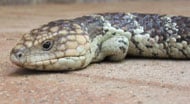Shingleback Skink
Inland Australia
The shingleback skink is a relatively hardy captive if attention is paid to a few details of its natural history. Keeping its environment dry is the main one they experience skin and toe degeneration problems if moisture and bacteria build up in the substrate of the enclosure. A single burrow retreat can be misted once per week, but otherwise the cage should stay dry. Introduce a small but heavy water bowl in a cage corner once per week for drinking, but remove after only a day so it doesn’t get spilled and wet the sand or gravel bedding.
Shingleback skinks are closely related to the blue-tongue skinks and can be kept under much the same conditions in captivity. They are omnivorous feeders. Shingleback skinks accept all kinds of small animals and invertebrates, and also soft greens and fruits. Variety is the spice of life, so offer plenty of it from week to week. A raw egg once per month is savored.
Shingleback skinks occasionally see frost in winter in some parts of the range, but in captivity they should only reach down into the 60s or high 50s as an overnight phenomenon when the opportunity to warm up in the morning will follow. Set a heat lamp aimed downward at one end of their cage, so they can move into the warmth when the light comes on early in the day.

